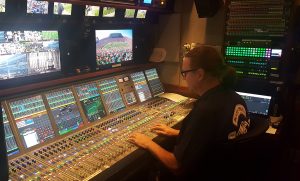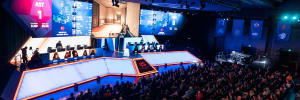2018 in Review: A Pivotal Year in Audio
IP, immersive sound were increasingly important to broadcast production
Story Highlights
2018 will be looked back on as a pivotal year: IP production techniques and technology became more firmly and deeply embedded in broadcast audio, and immersive sound moved from novelty to reality.
Intercoms provided a view into the migration to IP, thanks to products like Clear-Com’s high-density audio- and intercom-over-IP connection card for Eclipse HX digital systems and Telos’s Infinity IP Intercom. The latter converges voice communication and contribution audio on a single IT backbone using standards-based VoIP and Livewire+ AES67 AoIP transport. It also extends to wireless microphones, such as Alteros’s GTX Series L.A.W.N. (local-area wireless mic network), a 6.5-GHz ultra-wideband system.
“No doubt wireless intercoms will continue to be a major focus, after the changes in the UHF range, but the interesting stuff is coming out of SMPTE 2110,” says Clear-Com Marketing Outreach Manager Vinnie Macri, referring to the recently released (and still evolving) suite of standards around media over IP.

NBC Sports Group added Dolby Atmos audio to its 4K coverage of Notre Dame home games. Here, A1 Doug Deems is at the Calrec Artemis console aboard NEP’s ND6 unit.
IP also extended further into audio consoles: Solid State Logic’s System T-300 compact broadcast console — a dedicated, entirely IP-based, live-to-air broadcast-audio–production system with AoIP as its core — and Wheatstone’s IP 64 digital mixing console with AES67 compatibility, touchscreen control, and WheatNet IP networking for routing and controlling audio.
And it extended to live venue sound. According to Ben Cating, a senior consultant and VP at A/V consultancy Idibri, which has worked on such venues as Angels Stadium of Anaheim and US Bank Stadium in Minneapolis, most new sports-venue sound systems now encompass some degree of dedicated audio networking. It was a transition that happened quickly, he says, propelled by manufacturers’ integration of various networking protocols, including AES67 and AVB standards, and by widespread Dante compatibility.
Immersive Into the Mainstream
On the immersive side, Dolby’s Atmos system continued making strides, including test runs for NHRA and college football. Broadcasts by the NBC Sports Group of Notre Dame home games in 4K, which last year for the first time included Dolby Atmos audio. Instead of the usual side-by-side two-truck production, a single production truck output two formats, foreshadowing more-efficient production workflows.
“It makes total sense that, if you’re delivering the video in very high definition, it should be paired with next-generation audio,” says Karl Malone, director of sound design, NBC Sports and NBC Olympics. “I’m a great believer in tying [high-definition] formats together.”
As the Atmos format gathered momentum, online training modules in it were developed for Dolby by the Conservatory for Recording Arts & Sciences.
But MPEG-H, a competing immersive format developed by the Fraunhofer Institute, had its own successes, most notably delivering the Winter Olympics to host country Korea’s main broadcast networks and, more recently, with Chinese broadcasters.
The potential spur for consumer uptake of immersive sound might turn out to be the soundbar, which Dolby Senior Product Marketing Manager Rob France says will find a position within the immersive-monitoring chain on the production and post side even as it’s finding its way into living rooms: “We think they’ll be integrated in a similar way to 5.1-surround soundbars — from content creation to distribution to playback.”
Wired Athletes
Sound from the field and the athletes got a big boost in 2018. “Microphones on athletes have become mainstream at this point and [are] pretty much expected when it comes to the NBA,” says Paul Johnson, CEO of Q5X, the Canadian firm that developed the PlayerMic, which the NBA has been using for broadcasts since 2011.
Ear-catching demonstrations were heard during a number of milestone events, such as the MLB All-Star Game, for which 16 Q5X AquaMics were buried in the outfield. At tennis’s US Open, players were wired with a lavalier microphone as soon as they left the locker room after their matches, letting viewers listen in to conversations with trainers and fans before the players arrived at the broadcast set for interviews with ESPN hosts; the Alteros GTX Series L.A.W.N. 6.5-GHz IP-based wireless microphone systems were connected with DPA headsets and Audio-Technica AT899 lavalier mics. Also last year, the Canadian Football League joined the NFL in wiring players and officials for sound on a regular basis, with both coaches and quarterbacks miked for selected games through a total of six wireless channels. And then there was The Match, the PPV duel between Tiger Woods and Phil Mickelson, in which Turner Sports took live sound from the field to an entirely new level.
Riffing on RF
A year after the conclusion of the largest RF reallocation ever, plenty of new wireless microphone systems came to market in lots of new parts of the spectrum. Among them were Shure’s ULX-D and QLX-D systems in the 900 MHz band, Microflex wireless system for DECT, and the GLX-D digital wireless system for 2.4 GHz; and Sennheiser’s Evolution wireless EW 300 G3 and EW 500 G3 wireless microphone and monitoring systems for the 470-516 MHz range and the flagship Digital 9000 and Digital 6000 series, aimed at the license-free 1.9 GHz band.
However, Professional Wireless President Jim Van Winkle, RF coordinator for the NFL and other sports leagues, notes, “We’re encouraging more use of wired microphones, such as for brief sideline interviews, to help free up spectrum at big events.”
It also became clear during the year that the White Spaces databases, established by the FCC to manage the new spectrum landscape, have not been kept up-to-date, even as awareness of the need to use the databases was significantly lacking among many wireless-microphone user cohorts. Henry Cohen, senior RF systems design engineer, CP Communications, and a principal in RF consultancy Radio Active Designs, points out that the databases still contain numerous errors and omissions and that some registrations have simply disappeared, contributing to instances of RF interference for some registered users.
Live Sports, Live Sound
sports Venues got bigger in 2018, and their sound followed suit. According to Mike Hedden, president/CEO, Danley Sound Labs, whose Jericho systems saw action in the Atlanta Falcons’ new Mercedes-Benz Stadium last year and in the University of Georgia’s new 93,000-seat Sanford Stadium in Athens, the growing integration of massive videoboards and sound systems reflects a major trend in sports-venue design. “The new videoboard is 33% larger than the previous board,” Hedden says. “So we are doubling the horsepower in the loudspeakers, subwoofers, and amplifiers.”
However, John Monitto, director of business development, Meyer Sound, which installed a 178-loudspeaker LEO system at Detroit’s Ford Field, expresses some concern about large-scale integration of sound and video. “As screens become bigger and resolution becomes higher, he explains, “lip sync becomes harder to achieve with point-source sound systems,” the type of systems often found in the largest college football stadiums: spoken dialog reaches ears disconcertingly behind moving lips on the screens. “The solution,” he says, “is to resort to distributed-sound systems.”
Last year’s spending on construction of sports stadiums and arenas is estimated at $4.1 billion, per trade group AVIXA, and is expected to reach nearly $6 billion this year. A/V technology will likely drive much of that growth.

The $10 million,1,000-seat Esports Stadium Arlington in Texas is the largest dedicated esports stadium in the U.S.
The Esports Effect
Esports became a legitimate contender as a major-league sport in 2018, with millions of dollars spent on dedicated venues, such as Allied Esports International’s 30,000-sq.-ft., multilevel Esports Arena Las Vegas in the Luxor hotel and casino and the $10 million, 100,000-sq.-ft., 1,000-seat Esports Stadium Arlington in Texas, the latter being the biggest esports stadium in the U.S. Esports is expected to become a $1 billion industry this year and reach a value of $2.3 billion by 2022.
Get your VR goggles on, because, if 2018 is any indication, 2019 will be quite a ride.
